Part of a series of articles titled Women's History to Teach Year-Round.
Article
(H)our History Lesson: The World War II Navy Women of Floyd Bennett Field
Introduction
"Women's History to Teach Year-Round" provides manageable, interesting lessons that showcase women’s stories behind important historic sites. In this lesson, students explore the World War II effort through the experiences of three women who served in the United States Naval Reserve, better known as the WAVES, at Floyd Bennett Field in Brooklyn, New York.
This lesson was adapted by Talia Brenner and Katie McCarthy from the Teaching with Historic Places lesson plan, “Floyd Bennett Field: Naval Aviation's Home in Brooklyn.” If you're interested in more information and activities on this topic, explore the full lesson plan.
Grade Level Adapted For:
This lesson is intended for middle school learners but can easily be adapted for use by learners of all ages.
Inquiry Question:
Who are the women in this photograph? What details do you see that makes you think that?
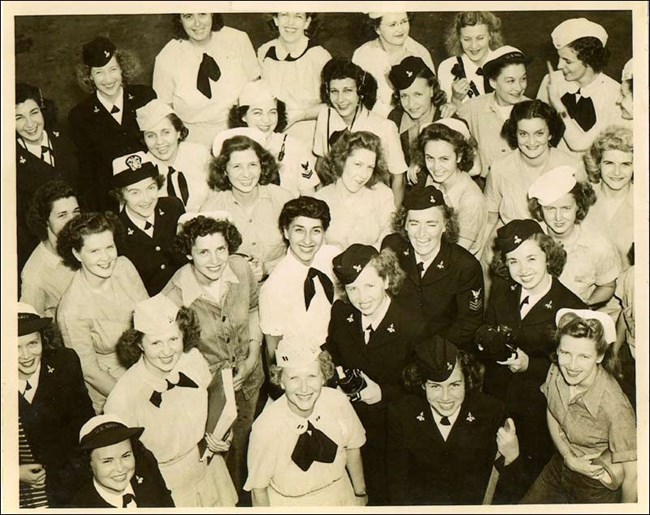
Lesson Objectives:
Learners will be able to...
-
Describe the women who worked at Floyd Bennet Field during WWII and the tasks they took on.
-
Outline the contributions of the WAVES during WWII.
-
Determine the central ideas or information from primary sources such as posters, oral histories, or songs.
-
Identify aspects of these primary sources that reveal an author’s point of view or purpose.
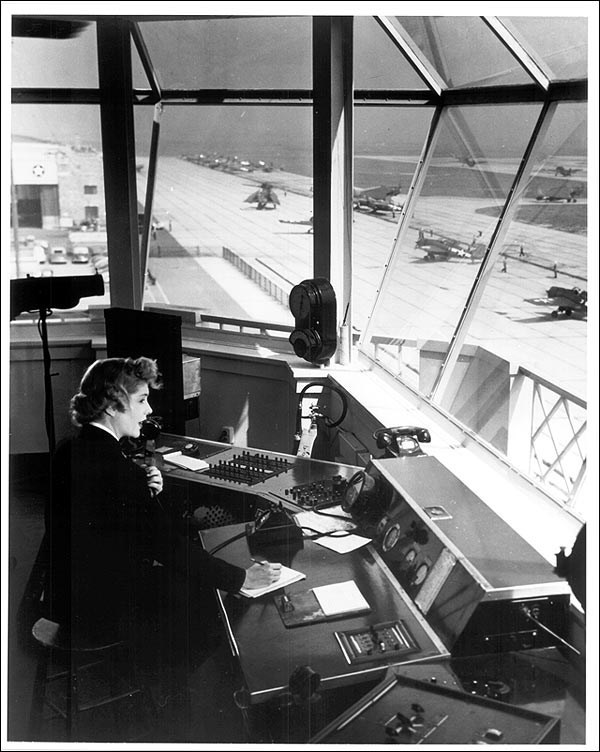
Background
When it opened in 1931, Floyd Bennett Field was not a military airport. In the 1930s, commercial pilots, including famous aviators, used the Brooklyn airfield. Several women pioneers, such as Laura H. Ingalls and Jacqueline Cochran, set aviation records from its runways. The U.S. Navy acquired the airfield in June 1941, six months before it entered World War II (1939-1945) in December 1941. The naval air station at Floyd Bennett Field soon became the busiest in the United States.
With so many men fighting in the war and an increased need for workers to produce military equipment, the U.S. Armed Forces and the companies it contracted began to hire women to fill jobs that were previously only open to men. These positions included factory workers, engineers, air traffic controllers, and test pilots. Motivated by patriotism and a desire for independence, adventure, and good pay, women of various ages, races, and education levels went to work in these jobs. Their contributions helped the Allies win both the Atlantic and Pacific fronts of the war.
Women participated in the World War II effort at sites all over the country. During the United States’ participation in World War II, hundreds of women served at the naval air station at Floyd Bennett Field. Many of the women working at Floyd Bennett Field were part of the United States Naval Reserve, better known as the WAVES (Women Accepted for Volunteer Exceptional Service).
Document 1: Memories of Fran Boggs Metcalf
On December 7, 1941, the entire United States of America was shocked, frightened and angry that the Japanese would dare to attack our country. This horrible tragedy soon emanated into sensational, nationwide patriotism…My brother Jim was in the Navy, stationed at a Navy air base at that time, and wrote interesting letters about how much he enjoyed being an aviation mechanic. He was very convincing and I decided right then that I was going to join the Navy and follow in his footsteps…
On my 20th birthday, since this was the age requirement, I took a streetcar downtown and was sworn in as a Navy WAVE, an acronym for Women Accepted for Volunteer Emergency Service…It was July 21, 1944 when I was sworn in on a delayed entry…
Finally, I arrived at Floyd Bennett Field Naval Air Station. We were quartered in the women's bunkroom, 50 women to each bunkroom, four bunks to a cubicle (two upper, two lower), with clothes closets at the end of the bunks…We had a community type shower, no curtains or privacy, with long rows of sinks, toilets and mirrors adjoining the shower room…
There was practically no dissention, as the women were all congenial. I remember only two incidents in the bunkroom. One person wanted to keep her kitten in the barracks, while others didn't like the idea. The other instance was the time when some of the women wanted the windows open, while only one woman objected. Their differences were settled amicably…
Women could be in the WAVES if they were married with no children, but not if they were pregnant, which is not the case today. I remember that one woman was discharged when it was discovered that she was pregnant.
We were not allowed to leave the base in slacks. Full dress uniforms were mandatory. Slacks and jeans were proper dress on the base. I remember my bell-bottom jeans that were so comfortable for working…
I was finally assigned to an airplane crew... I carried lots of tools, washed props down, changed oil filters, unbuckled cowling and dusted cockpits. I worked on F4Us, F4Fs and PBYs…
I never accomplished my intention of becoming an airplane mechanic…While many of the women were adept in their jobs as mechanics, that wasn't in my future. One morning a WAVE officer walked through the ACU Outfights office and was incensed at the language that she heard. She told them to get a woman in that office immediately. So, that is how I finally got my job in the office of ACU Outflights, logging in airplanes flown in from Grumman Aircraft, and then logging them out, after they were checked by the plane crews, to go aboard aircraft carriers going out to sea…
I recall how I kept aspirin in my desk drawer at ACU Outflights for the young sailors, many younger than myself, who would arrive for duty with terrible hangovers. I knew it was possible they could be transferred onto ships going out to sea. Some of them were only 17 and I was 20, so they seemed like little boys to me.
I still meet with my bunkmate, Amy Foster Feluk, several times a year continuing our 60-year friendship in 2004…
Document 1 was written by Fran Metcalf, March 22, 2004. Fran’s complete memories are available in the National Archives’ catalog.
Discussion Questions
-
Discussion Questions
-
Why did Fran keep aspirin in her desk for the young sailors?
-
Why do you think the WAVE officer wanted to “get a woman in that office” with the men who used foul language?
-
Why do you think that WAVES were not allowed to leave the base wearing pants? How do you think Fran felt about this rule?
-
What were Fran’s reasons for joining the WAVES?
Document 2: Memories of Amy Foster Feluk
I went into the Navy in September 1944. Boot Camp was at Hunter College in the Bronx, New York…Finally, I was assigned to Floyd Bennett Field in Brooklyn, New York. I went from the Bronx, Hunter College to Flatbush by the subway, by myself. They gave me instructions on how to travel. A "cattle car" met me at the Flatbush Avenue subway station and took me to Floyd Bennett Field. The cattle cars were semis with enclosed trailers. When I arrived at the front gate, they checked me in, and sent me to the WAVES barracks.
WAVES were on duty on a four-day duty schedule. One weekend we were off on Saturday, one weekend we were off on Sunday, one weekend we were off on Saturday and Sunday, and one weekend we were on duty all weekend…
On the base WAVES had to go to mess, church or the PX (post exchange) by cattle car. Standing room only! …The hangars were on the opposite side of the base. I worked in Hangar A. I was a trainee Apprentice Aviation Machinist Mate. The unit was A.C.U. or Aircraft Commissioning Unit…
On weekend pass or anytime we were free, the WAVES normally headed for Manhattan. WAVES would leave the base in cattle cars and go into Flatbush to take the subway into Manhattan. We would go to the U.S.O. [an organization that provides services to people in the military] first. It was located on Times Square. The U.S.O. would have free tickets or passes for musicals, movies, roller skating, dance clubs like the Copacabana and Toots Shor's, and to Radio City Music Hall.. If we stayed in Flatbush, WAVES would go to the Blue Mirror, which had dancing and drinks, or we would go to a restaurant to have some "good" food like hamburgers, hot dogs and food we didn't get on the base. Sometimes we went to Coney Island in Brooklyn…
One thing I learned was to watch out for props when they were turning. I saw one sailor lose the top of his head when he walked into the propeller.
While being on the basketball team I sprained both knees while guarding. The game was between Christmas and New Year 1945 in Rhode Island. When I came back I was put on KP [kitchen police] in our bunkroom. I was there for two months, as I could not work on the airplanes at the time.
Document 2 was written by Amy Feluk, March 22, 2004. Amy’s complete memories are available in the National Archives’ catalog.
Discussion Questions
-
Why do you think Amy emphasized the fact that she traveled to Flatbush by herself?
-
What does the fact that Amy could not work on the airplanes with sprained knees tell you about the physical requirements of her job?
-
Did Amy and the other WAVES do more relaxing or more exciting activities on their days off? Why do you think they sought out that type of activity?
Activities:
The following activities encourage learners to place themselves in the WAVES’ shoes and think both creatively and analytically. Educators should choose one of the following activities to complete with their participants.
Activity 1: Creative Writing
Have participants select a specific event described in one of the above documents. Then, have participants write a diary entry about the event from the perspective of the woman who wrote the document. Participants can be creative in describing their characters’ feelings, but their diary entries must fit in factually with the information they know about their characters’ lives and experiences in the WAVES.
Activity 2: Analyzing Popular Culture
Have learners observe the following recruiting posters for the WAVES and answer the first set of questions below, working either individually or in small groups. Then, listen to the song “Rosie the Riveter” (sung by The Four Vagabonds, widely available online). Inform learners that although the song is specifically about a factory worker (a riveter), it shows a popular attitude that Americans had toward women working in the World War II effort. You might want to distribute the song lyrics to learners and/or play the song twice through. After learners have listened to the song, have them answer the second set of questions. Once participants have answered both sets of questions, discuss the following question: Based on the song and the posters, what was the ideal image of a woman working for the military during World War II? With this in mind, have participants create their own version of a WAVES recruitment poster. As learners work, have them consider what aspects of the WAVES’ role they should highlight to capture their audience.
Image 1
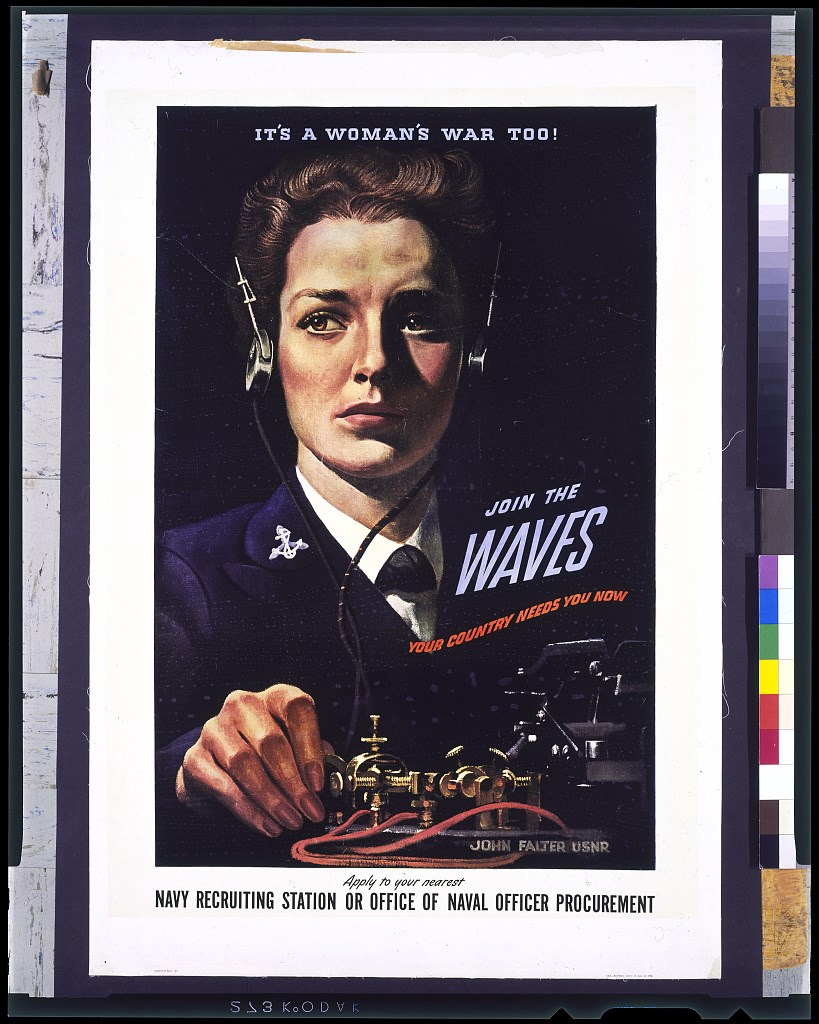
John Philip Falter, 1942. Courtesy Library of Congress.
Transcription
It's a woman's war too!
Join the WAVES
Your Country Needs You Now
Image 2
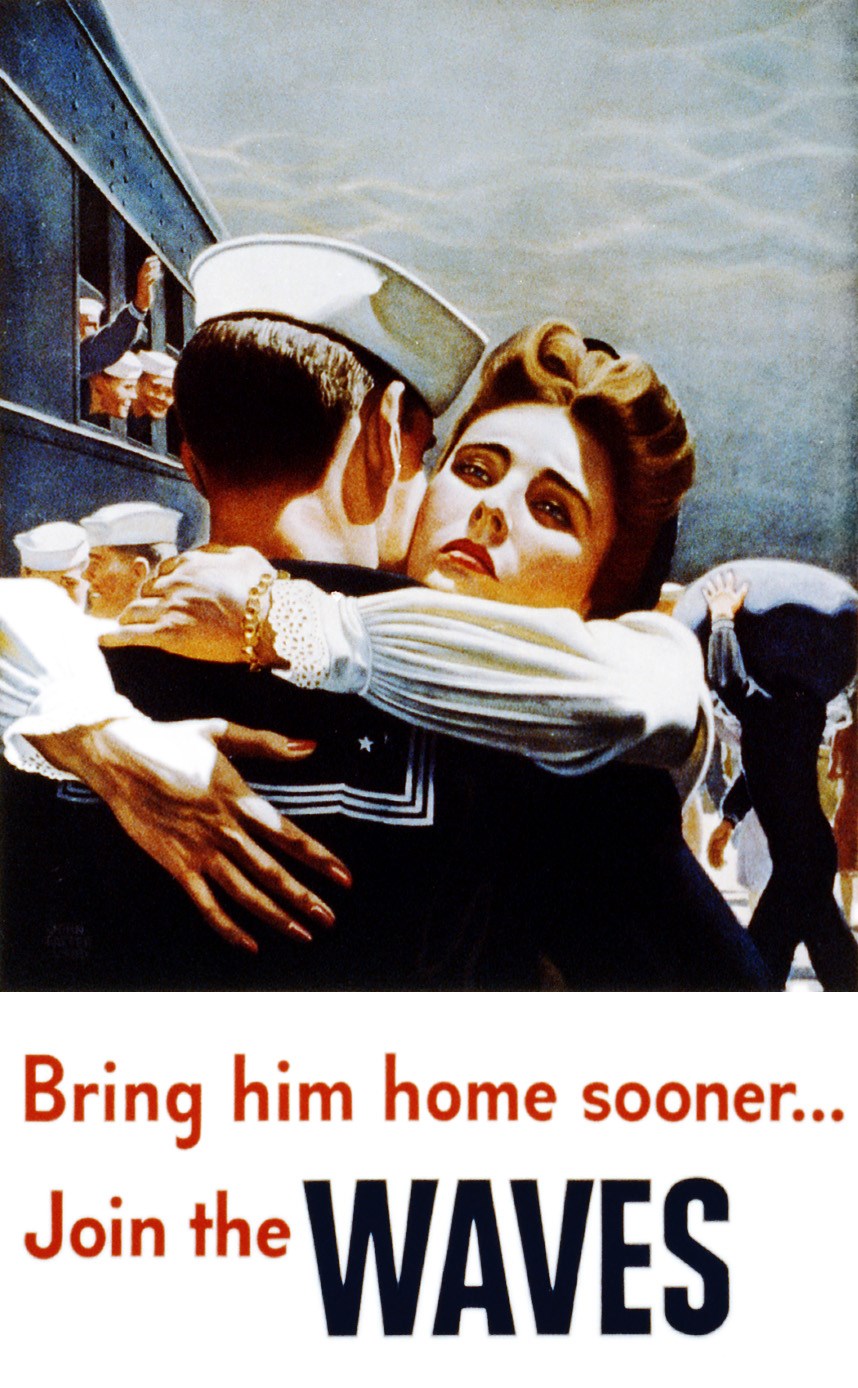
Transcription
Bring him home sooner...
Join the WAVES
Image 3
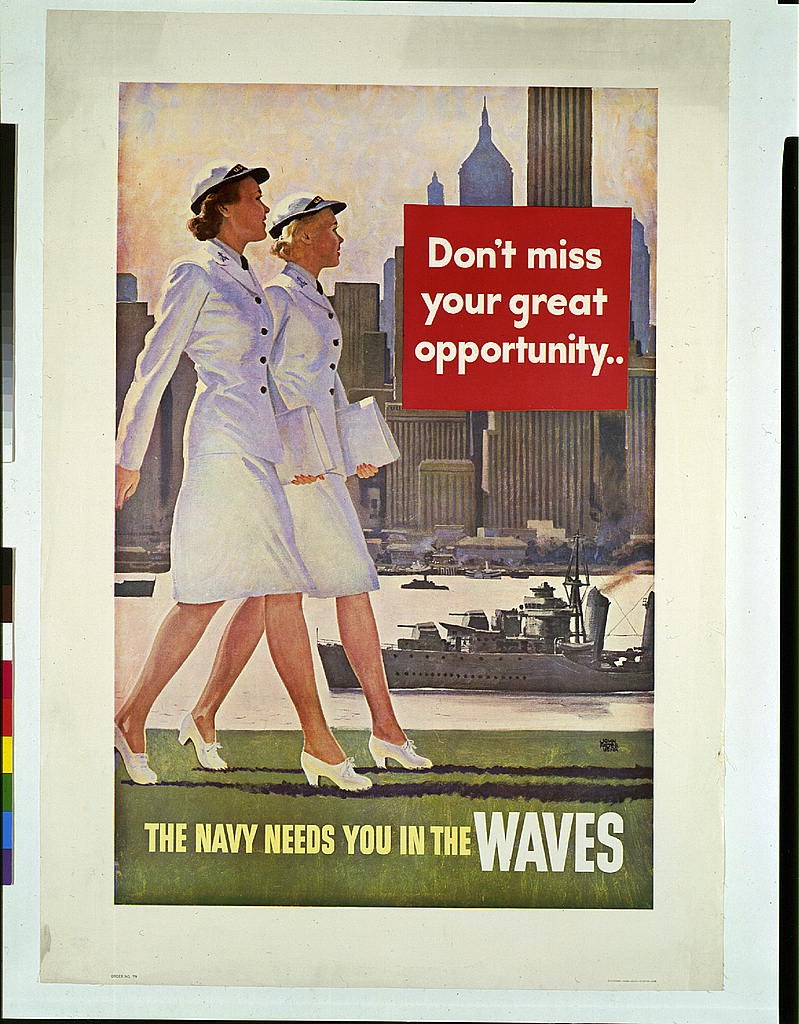
Transcription
Don't miss your great opportunity..
The Navy needs you in the WAVES
Questions for WAVES Recruitment Posters
-
For each poster, summarize the main claim by using this model: “Join the WAVES because ______________________”
-
In Image 3, how would you describe the women’s surroundings? What message do you think that image is trying to send?
-
How would you describe the appearance of the women who appear in the posters? Do you think all women who served in the WAVES looked like the women in the posters? Why do you think the artist chose to draw the women in the posters that way?
-
If you were to create your own WAVES recruitment poster, what would you highlight in the appearance, surroundings, and activities of the WAVES?
Questions for "Rosie the Riveter”
-
Is the song’s depiction of Rosie positive, negative, or mixed?
-
According to the song lyrics, what are Rosie’s characteristics?
Wrap-up:
-
What kinds of challenges did women face when they enlisted in the WAVES? How do you think they felt about those challenges?
-
What motivated women who enlisted in the WAVES? Have you ever needed extra motivation to start a task or a new role? What motivated you then?
-
Many communities have memorials for those who participated in WWII or preserved places commemorating the war. Are there any in your community?
Additional Resources:
Floyd Bennett Field Resources:
Gateway National Recreation Area
Gateway National Recreation Area is a unit of the National Park System which preserves 26,000 acres in the greater New York City metropolitan area. This website provides general visitor's information about facilities, times of operation, junior ranger programs and special events. Links at this website take teachers and students to the Teaching with Historic Places lesson for another unit of this park, Fort Hancock, a military monument of an earlier era.
World War II History Resources:
Department of the Navy, Naval Historical Center
The Naval Historical Center’s website is a valuable resource for information about all aspects of the U.S. Navy in World War II, including photographs, oral histories, official U.S. navy documents, and much more.
The National Archives, A People At War
This online exhibit chronicles the experiences of the people of the United States during World War II through written documents, photographs, posters, petitions, and other primary sources. The segment on Women Who Served features the WAFS/WASPS, the Women's Auxiliary Ferrying Service who, like VRF-1, delivered airplanes to units across the country.
Women Veterans Historical Project, UNC Greensboro
This digital collection houses oral histories, photographs, posters, diaries, letters, and other primary sources from women who served in or with the military from World War I to the present day.
Tags
- teaching with historic places
- twhp
- new york
- new york history
- new york city
- women's history
- labor history
- military wartime history
- science
- early 20th century
- world war ii
- world war 2
- women at war
- floyd bennett field
- women in wartime
- navy history
- navy
- hour history lessons
- educational activity
- aviation
- women in science and technology
- women in the labor movement
- military history
- wwii home front
- world war ii women breaking barriers
- women and the economy
- science and technology
- world war ii veterans
- twhplp
- world war ii home front
Last updated: February 9, 2024
